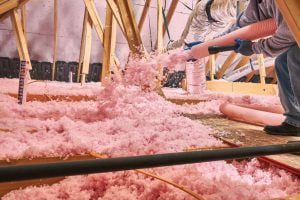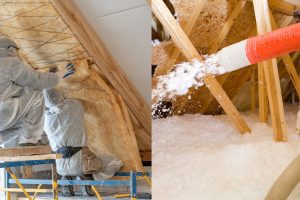Is your home equipped with effective insulation? Insulation is an essential factor in enhancing the energy efficiency of your dwelling. Choosing the exact type of insulation that can offer the best energy conservation is vital.
If you’re considering blown-in or rolled insulation, it’s important to note the differences and how they can enhance your home’s energy efficiency. Let’s explore what you need to know about these insulation types.
Overview of Blown-in Insulation
Blown insulation is a process where small fragments of recycled materials like cellulose or fiberglass are forced into the attic or any other space requiring insulation. This insulation method is preferred for hard-to-reach areas as the loose materials delicately insulate the corners.
Advantages of Blown-in Insulation for Energy Efficiency
The primary advantage of blown-in insulation is its comprehensive coverage. When compared with rolled insulation, blown insulation has proven more efficient for climate control as it covers even the smallest spaces. It can be more expensive up-front, but over time, the reduction in energy costs pays for the difference.
Overview of Rolled Insulation
Rolled insulation is a type of insulation composed of fiberglass in a blanket-like format. It’s perfect for large, open spaces like the attic floor. Its installation generally doesn’t require heavy-duty tools apart from a standard staple gun and a utility knife.
Benefits of Rolled Insulation for Energy Efficiency
One of the critical benefits of rolled insulation is its ease of installation. Most of the time, homeowners can install rolled insulation by themselves. It does provide effective climate control, but not as comprehensively as blown-in insulation.
Disadvantages of Rolled Insulation
The disadvantage of rolled insulation lies in its inability to insulate every corner adequately. Furthermore, incorrect installation can lead to gaps and compression that decreases its insulating properties.
Comparative Analysis: Blown-in vs. Rolled Insulation
Installation Difficulty
Blown-in insulation is typically installed using a blowing machine to distribute loose insulation material evenly throughout the attic or wall cavity. It involves creating a thick insulation layer by blowing the material in place. This method is often used for retrofitting existing structures, as it can be installed without significant disruption to the building’s structure.
On the other hand, rolled insulation comes in pre-cut rolls or batts of specific dimensions and is usually made of fiberglass, mineral wool, or other materials. It is installed by unrolling the material and fitting it between wall studs, ceiling joists, or floor joists. This method is more commonly used in new construction or areas with easy access to the framing.
Cost Effectiveness
Comparing blown and rolled insulation, the cost varies depending on the project’s scope. Rolled insulation generally has a lower upfront cost than blown insulation. However, blown insulation tends to have a higher R-value, meaning it can provide superior attic insulation, creating potential for cost savings on heating and cooling bills in the long term.
Energy Efficiency
Blown-in insulation tends to be more energy efficient than rolled insulation due to its better sealing capabilities. Blown insulation quickly expands to fill gaps, enabling better air sealing and making it an excellent choice for attic insulation. On the other hand, rolled insulation needs to be carefully installed to avoid gaps that can reduce the insulation’s effectiveness.
Factors to Consider When Choosing Between Blown-in and Rolled Insulation
Choosing between rolled and blown-in fiberglass insulation involves considering several factors to ensure you select the most suitable option for your project and requirements. Here are the key factors to consider:
- Insulation Goals: Determine your insulation goals, such as improving energy efficiency, reducing heat loss or gain, or soundproofing.
- Location: Consider where you intend to install the insulation. Blown-in insulation is often preferred for attics and hard-to-reach spaces, while rolled insulation is more commonly used in wall cavities and areas with accessible framing.
- Existing Structure: Assess the condition of the existing structure. Blown-in insulation may be a better choice for retrofitting older buildings with irregular spaces and obstructions. In contrast, rolled insulation is easier to install in new construction or areas with precise framing.
- Consult a Professional: When in doubt or have unique circumstances, consult with a professional insulation contractor or an energy auditor who can assess your specific needs and recommend the best insulation solution.
Look to Cincinnati RetroFoam for Your Insulation Needs
If you’re looking for quality home insulation, look to Cincinnati RetroFoam. Our mission is to provide outstanding insulation services you can’t find elsewhere. We offer injection foam, spray foam, and blown-in insulation for your needs. No matter the project, we bring 100% to every job and offer superior craftsmanship. Contact us today for your free quote.


